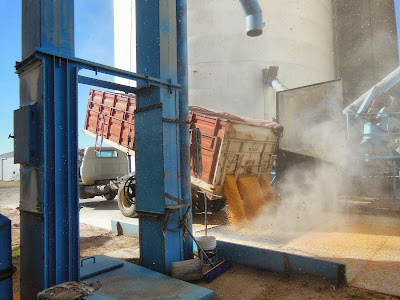
Then and now ...
Some harvest scenes haven't changed. A blue Kansas sky provides a backdrop as a combine unloads golden grain into a waiting truck. But compare the 1950s-era truck and combine with today's machines, and it's like the farm version of "Honey, I Shrunk the Kids."
This 1970s-era truck driver has changed a bit, too. But, as a farm daughter turned farm wife, harvest is still part of my DNA.
My Dad had me helping in the harvest field at about age 12. I began moving the grain trucks around in the wheat field before I was old enough to make trips to the elevator. After my Dad would make another swath with the combine, I'd move the truck closer so he didn't have to take time driving to the truck.
When I had my farm permit, I was promoted to a "real" truck driver and took loads of wheat to the Iuka Co-op. I remember being coached by my Dad and also by a truck driver named Ed, who taught me the fine points of waiting in line, unrolling the tarp, how to dump the truck and instructions in the fine art of elevator etiquette.
After last harvest's truck troubles, we upgraded to a semi. It's been a great addition to the farm fleet. We used it during corn harvest last year, but this is our first wheat harvest using it. Since it can hold much more than a traditional farm truck, it requires fewer back-and-forth trips to the elevator.
Jake usually drives the semi, but I went along for the ride when Randy was the driver. (Yes, I could learn to drive the semi if needed. So far, my services have not been required.)
It's definitely a different vantage point traveling down the road in a semi.
Here, we arrive at the Zenith branch of the Kanza Co-op.
Randy unrolls the tarp.
He pulls the semi onto the scales at the co-op office, where they weigh the loaded truck. With the orange probe, they get a sample of the wheat and test for quality, including weight, moisture, protein and foreign matter.
At Zenith, there are two dump sites. This time, we were directed to the dump site outside the elevator.
Randy waits while another truck pulls out.
Once the truck is in position, the co-op workers open the hatches underneath the truck. The truck is emptied through gravity.
We still use the tandem truck as needed. A hoist lifts the truck bed on the old truck. Here are some photos from corn harvest that illustrate the difference:
A co-op worker opens the slides on the back of the truck, then signals the driver to begin raising the truck bed. As the driver, you watch in your rearview mirror and watch for hand signals from the co-op worker. Sometimes, they want you to pause so the grain doesn't pile up.
The bed is fully raised in the photo below. Once the truck is empty, the driver puts down the truck bed back down before pulling away.
No matter the method, it's a dirty job with all the grain dust swirling around!
Once the grain was unloaded from the semi, Randy pulled away for the trip back to the scales.
They weigh the empty truck and can then determine how much wheat we delivered to the co-op. Below, Tara gives Randy the ticket with the information about quantity and quality. If you click on the photo to make it bigger, you can see she's using a yardstick contraption to reach the driver's hands. That way, it saves steps for everybody.
Right before we pulled away, we took a look at the market board in the window. (This was from a week ago, so the prices reflect the June 23 price.) The wheat is stored at the co-op until we are ready to sell it
The farmer or landlord pays a storage fee to the co-op based on the amount of time the grain was stored before being sold. Then, it belongs to the co-op. When they sell it, most is trucked out of the elevator to the buyer. (In the past, rail travel helped move a lot of grain, too, but most of it is trucked these days, at least in this area.)
Then it was back to the field to do it all over again.


















Thanks for the interesting post! We never see the truck full of beans/barley/wheat after it leaves our farm, so it's fun to see how it all works. Let's hope those doors under the trailer never open accidentally before they're supposed to! :)
ReplyDeleteI hope not either, Alica! We've definitely had the hatches on the smaller trucks left open or partially open, though it hasn't happened often. It's like a slow leak, which deposits grain behind the truck as it sits there to get filled again. It's not a fun clean-up!
DeleteLove those shorts
ReplyDeleteEspecially with the knee socks, right?!
ReplyDelete